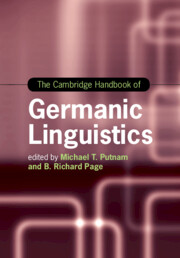Book contents
- The Cambridge Handbook of Germanic Linguistics
- Cambridge Handbooks in Language and Linguistics
- The Cambridge Handbook of Germanic Linguistics
- Copyright page
- Contents
- Figures
- Maps
- Tables
- Contributors
- Acknowledgments
- Germanic Languages
- Part I Phonology
- Part II Morphology and Agreement Systems
- Part III Syntax
- Part IV Semantics and Pragmatics
- Chapter 24 Modality in Germanic
- Chapter 25 Tense and Aspect in Germanic Languages
- Chapter 26 Prepositions and Particles
- Chapter 27 Negative and Positive Polarity Items
- Chapter 28 Grammatical Reflexes of Information Structure in Germanic Languages
- Part V Language Contact and Nonstandard Varieties
- Index
- References
Chapter 25 - Tense and Aspect in Germanic Languages
from Part IV - Semantics and Pragmatics
Published online by Cambridge University Press: 31 March 2020
- The Cambridge Handbook of Germanic Linguistics
- Cambridge Handbooks in Language and Linguistics
- The Cambridge Handbook of Germanic Linguistics
- Copyright page
- Contents
- Figures
- Maps
- Tables
- Contributors
- Acknowledgments
- Germanic Languages
- Part I Phonology
- Part II Morphology and Agreement Systems
- Part III Syntax
- Part IV Semantics and Pragmatics
- Chapter 24 Modality in Germanic
- Chapter 25 Tense and Aspect in Germanic Languages
- Chapter 26 Prepositions and Particles
- Chapter 27 Negative and Positive Polarity Items
- Chapter 28 Grammatical Reflexes of Information Structure in Germanic Languages
- Part V Language Contact and Nonstandard Varieties
- Index
- References
Summary
Many natural languages signal via designated grammatical markers the time when a predicated event takes or took place; in the past, the present, or the future. Such designated markers are for instance particular inflections (affixes), particles, or auxiliaries, usually elements with an affinity to the verbal domain. Exponents serving to locate a situation in time, especially relative to the moment of utterance or the speech event, are described as tense markers. Likewise, languages often encode the internal constituency of events and states, distinguishing a dynamic action from a stative one; denoting whether or not an action is bounded or unbounded, completed, or if it repeats itself. These features of an event are usually described as their aspect. Tense and aspect interact in intricate ways cross-linguistically and have been subjected to scrutiny by several generations of grammarians. This chapter examines some seminal assumptions and descriptions of these notions with a particular view to Germanic languages.
Keywords
- Type
- Chapter
- Information
- The Cambridge Handbook of Germanic Linguistics , pp. 591 - 614Publisher: Cambridge University PressPrint publication year: 2020



